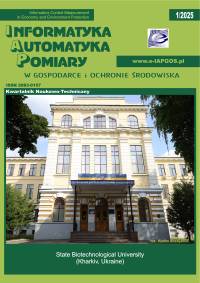ROZPOZNAWANIE EMOCJI W TEKSTACH POLSKOJĘZYCZNYCH Z WYKORZYSTANIEM METODY SŁÓW KLUCZOWYCH
Adrian Maciej Nowaczyk
amnowaczyk@gmail.comPolitechnika Łódzka, Instytut Informatyki Stosowanej (Polska)
Lidia Jackowska-Strumiłło
Politechnika Łódzka, Instytut Informatyki Stosowanej (Polska)
Abstrakt
Dynamiczny rozwój sieci społecznościowych sprawił, że Internet stał się najpopularniejszym medium komunikacyjnym. Zdecydowana większość komunikatów wymieniana jest w postaci widomości tekstowych, które niejednokrotnie odzwierciedlają stan emocjonalny autora. Identyfikacja emocji w tekstach znajduje szerokie zastosowanie w handlu elektronicznym, czy telemedycynie, stając się jednocześnie ważnym elementem w komunikacji człowiek-komputer. W niniejszym artykule zaprezentowano metodę rozpoznawania emocji w tekstach polskojęzycznych opartą o algorytm detekcji słów kluczowych i lematyzację. Uzyskano dokładność rzędu 60%. Opracowano również pierwszą polskojęzyczną bazę słów kluczowych wyrażających emocje.
Słowa kluczowe:
rozpoznawanie emocji, interakcja człowiek-komputer, przetwarzanie języka naturalnego, przetwarzanie tekstówBibliografia
Binali H., Wu C., Potdar V.: Computational approaches for emotion detection in text, 4th IEEE International Conference on Digital Ecosystems and Technologies, Dubai, 2010, 172–177 [DOI:10.1109/DEST.2010.5610650].
Google Scholar
Buckland M., Gey F.: The Relationship between Recall and Precision. Journal of The American Society For Information Science 45(1)/1994, 12–19 [DOI:10.1002/(SICI)1097-4571(199401)45:1<12::AID–ASI2>3.0.CO;2-L].
Google Scholar
Dung T., Cao T.H.: A high-order hidden Markov model for emotion detection from textual data. Lecture Notes in Computer Science 7457/2012, 94–105.
Google Scholar
Ekman P.: Basic emotions. The handbook of cognition and emotion. John Wiley & Sons, New York 1999.
Google Scholar
Elliott C.: The affective reasoned: a process model of emotions in a multi-agent system. Doctoral thesis on Northwestern University, 1992.
Google Scholar
Fellbaum C.: WordNet: An Electronic Lexical Database. MIT Press, Cambridge 1998.
Google Scholar
Ghazi D., Inkpen D., Szpakowicz S.: Hierarchical versus flat classification of emotions in text. NAACL HLT 2010 workshop on computational approaches to analysis and generation of emotion Computational Linguistics, 2010, 40–146.
Google Scholar
Hancock J., Landrigan C., Silver C.: Expressing emotion in text-based communication. Proceedings of the SIGCHI conference on Human factors in computing systems, 2007, 929–932.
Google Scholar
Kamińska D., Pelikant A.: Recognition of Human Emotion from a Speech Signal Based on Plutchik’s Model. International Journal of Electronics and Telecommunications 58(2)/(2012), 165–170[DOI:10.2478/v10177-012-0024-4].
Google Scholar
Khalili Z., Moradi M.H.: Emotion recognition system using brain and peripheral signals: using correlation dimension to improve the results of EEG. Proceedings of the International Joint Conference on Neural Networks 2009, 1571–1575.
Google Scholar
Ling H., Bali R., Salam R.: Emotion detection using keywords spotting and semantic network. Proceedings of the International Conference on Computing & Informatics 2006, 1-5 [DOI:10.1109/ICOCI.2006.5276495].
Google Scholar
Lu Ch., Lin S., Liu J., Cruz-Lara S., Hong J.: Automatic event-level textual emotion sensing using mutual action histogram between entities. Expert systems with applications 37(2)/2010, 1643–1653[DOI:10.1016/j.eswa.2009.06.099].
Google Scholar
Maziarz M., Piasecki M., Szpakowicz S.: Approaching plWordNet 2.0. Proceedings of the 6th Global Wordnet Conference, 2012.
Google Scholar
Plutchik R.: The nature of emotion. American Scientist 89(4)/2001, 344.
Google Scholar
Schachter S., Singer J.: Cognitive, Social, and Physiological Determinants of Emotional State. Psychological Review 69/1962, 379–399 [DOI:10.1037/h0046234].
Google Scholar
Stathopoulou I-O., Tsihrintzis G.: Emotion Recognition from Body Movements and Gesture. Proceedings of the International Conference on Intelligent Interactive Multimedia Systems and Services, 2011, 295–303.
Google Scholar
Strapparava C., Valitutti A.: WordNet Affect: an Affective Extension of WordNet. Proceedings of International Conference on Language Resources and Evaluation, 2004, 1083–1086.
Google Scholar
Ślot K., Bronakowski Ł., Cichosz J.: Application of voiced-speech variability descriptors to emotion recognition. Computational Intelligence for Security and Defense Applications, 2009, 1–5 [DOI:10.1109/CISDA.2009.5356537].
Google Scholar
Teng Z., Ren F., Kuroiwa S.: Recognition of Emotion with SVM. Artificial Intelligence 4114/2006, 701–710 [DOI:10.1007/11816171_87].
Google Scholar
Zheng W., Tang H., Lin Z., Huang T.: Emotion Recognition from Arbitrary View Facial Images. Proceedings of the 11th European Conference on Computer Vision, 2010, 490–503 [DOI:10.1007/978-3-642-15567-3_36].
Google Scholar
https://commons.wikimedia.org/wiki/File:Emotions_-_3.png [10.03.2016].
Google Scholar
Autorzy
Adrian Maciej Nowaczykamnowaczyk@gmail.com
Politechnika Łódzka, Instytut Informatyki Stosowanej Polska
Autorzy
Lidia Jackowska-StrumiłłoPolitechnika Łódzka, Instytut Informatyki Stosowanej Polska
Statystyki
Abstract views: 516PDF downloads: 8768
Licencja

Utwór dostępny jest na licencji Creative Commons Uznanie autorstwa – Na tych samych warunkach 4.0 Miedzynarodowe.
Inne teksty tego samego autora
- Michał Majchrowicz, Paweł Kapusta, Lidia Jackowska-Strumiłło, Dominik Sankowski, PRZYSPIESZANIE PROCESU REKONSTRUKCJI OBRAZU W ELEKTRYCZNEJ TOMOGRAFII POJEMNOŚCIOWEJ 3D Z WYKORZYSTANIEM HETEROGENICZNEGO SYSTEMU MULTI-GPU , Informatyka, Automatyka, Pomiary w Gospodarce i Ochronie Środowiska: Tom 7 Nr 1 (2017)
- Michał Paluch, Lidia Jackowska-Strumiłło, SYSTEM DECYZYJNY DO PRZEWIDYWANIA CEN AKCJI OPARTY NA SZTUCZNEJ SIECI NEURONOWEJ HOPFIELDA , Informatyka, Automatyka, Pomiary w Gospodarce i Ochronie Środowiska: Tom 6 Nr 2 (2016)
- Andrzej Romanowski, Krzysztof Grudzień, Hela Garbaa, Lidia Jackowska-Strumiłło, METODY PARAMETRYCZNE W ROZWIĄZYWANIU PROBLEMU ODWROTNEGO DLA MONITOROWANIA PRZEPŁYWÓW MATERIAŁÓW SYPKICH , Informatyka, Automatyka, Pomiary w Gospodarce i Ochronie Środowiska: Tom 7 Nr 1 (2017)
- Hela Garbaa, Lidia Jackowska-Strumiłło, Krzysztof Grudzień, Andrzej Romanowski, SYMULACJA PRZEPŁYWU GRAWITACYJNEGO I ESTYMACJA JEGO PARAMETRÓW PRZY UŻYCIU ELEKTRYCZNEJ TOMOGRAFII POJEMNOŚCIOWEJ I SZTUCZNYCH SIECI NEURONOWYCH , Informatyka, Automatyka, Pomiary w Gospodarce i Ochronie Środowiska: Tom 6 Nr 2 (2016)









